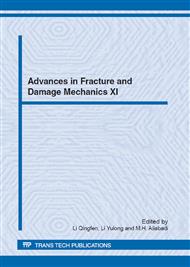p.213
p.217
p.221
p.225
p.229
p.233
p.237
p.241
p.245
Determination of Intensity Factors for Interfacial Cracks in TIP Materials
Abstract:
An explicit extrapolating formula for a general case of the interfacial crack plane lying with an angle to the poling axis in transversely isotropic piezoelectric (TIP) materials is derived, which is very feasible to determine the intensity factors for numerical methods such as FEM or BEM. Additionally, a more concise extrapolating formula for the typical state of the interfacial crack plane lying perpendicular to the poling axis is also presented in this paper.
Info:
Periodical:
Pages:
229-232
Citation:
Online since:
November 2012
Authors:
Price:
Сopyright:
© 2013 Trans Tech Publications Ltd. All Rights Reserved
Share:
Citation:


